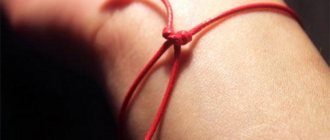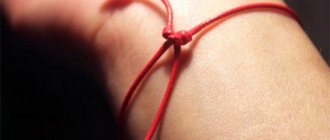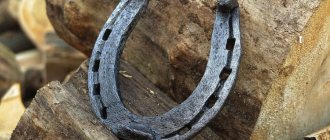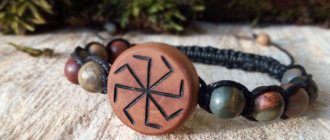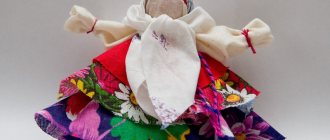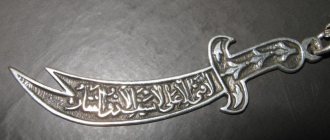A witch's ladder (witch's rope or cord, less commonly a loop) is an amulet made from a piece of leather cord into which magical objects and bird feathers are woven. The original use of this item is unknown, but modern magicians and sorcerers use such a ladder as a protective talisman. In ancient times it was equated with a much older item known as the Witches Garland, which was used by the witches of Italy to cast a death curse.
The garland was a rope with knots tied to which black chicken feathers were attached. They buried it in the ground, and as the rope decomposed, the damned man melted before his eyes, became sick, until he finally died. This property of the Witch's Garland immediately gave the "witch's ladder" a reputation as a dangerous magical instrument.
Another, more common belief was that the witch's rope was used as a counting device for repeated chanting while working spells; similar to how rosaries are used by Catholics when reciting repetitive prayers. This "counter" would have been considered very valuable, as it allowed the sorceress to focus more of her energy on spells or chants, rather than trying to keep track of the number of times each line was spoken.
How the first witch's ladder was discovered
There are several examples of old witch cords. But the oldest and most original copy dates back to 1878. It was discovered in an old dilapidated house in Wellington, Somerset, built in southwest England. Workers discovered an object hanging in the attic while demolishing the building. The cord was about five feet long with cock feathers inserted into it at regular intervals and a loop at one end. Next to the suspended cord stood a stool and six brooms.
The woman who owned the house was always suspected of being a witch. Superstitious workers declared the strange finds to be witch objects, thereby confirming the suspicions of local residents. It was decided that the brooms were used for flying, the stool for sitting, and the feathered cord served as a rope (or ladder) to allow the lady of the house and other witches to climb onto the roof. The latter conclusion was reached from the consideration that there was no other way to gain access to the attic space other than from outside the house, from the roof. Since then, the leather cord with knots and bird feathers has become known as the “witch’s ladder.”
What is the Witch's Ladder amulet?
To attract positive emotions in life, protect your home, and improve your personal life, it is recommended to make a witch’s ladder. It is a strong talisman for those people who have many problems in life. It is recommended to make an amulet yourself, using natural materials - thread, wool, linen, silk.
The key to creating a working amulet is the correct formulation of your own desires. Some people use the witch's ladder to cause damage or remove the evil eye or curse. To do this, it is advised to throw or give this talisman to the home of your worst enemy.
It is not recommended to buy this amulet from strangers; it can carry negative energy, including death. Even in the old days, the witch's ladder was made in order to protect the house from evil spirits, to attract monetary luck, family well-being, prosperity and happiness. Helps improve health. Eliminates negative thoughts and points you on the right path.
How the magic witch's ladder is used today
Since its initial discovery, modern pagans and witches have given a broader meaning to the "witch's ladder" and it has evolved into a tool for meditation, spell casting and more. You can make different ladders for different purposes, for example, for protection or fulfillment of desires.
The original design of feathers and cord was supplemented with bones, shells, amulets and other magical objects. Additionally, a more spiritual meaning was added by using colorful feathers and cords of three colors. As a result, another variation of the original design emerged, where instead of feathers, numbered groups of beads are the main part of the design, turning it into a kind of pagan strand of rosary. In addition, not only leather, but also ribbons, silk ropes or twines of various lengths began to be used as the basis for the cord.
What do feathers mean?
There are several meanings for the feathers of this amulet, the meaning of which varies depending on the color. A Witch's Ladder usually contains nine feathers, but it is best to use bird feathers found in the wild or given to you by another person. If this person is a witch, that's even better. Never use feathers collected or plucked from a living creature, or feathers from a dead bird. These feathers will have dead potential and will not work as needed.
So, the meaning of colored feathers in the witch's ladder:
- Red – for success, spiritual and physical vitality
- Blue – to stimulate mental activity
- White – for purity, hope, spirituality, peace and lunar blessings
- Yellow – for vigilance, financial gain and well-being
- Brown – for grounding, stability and respect from peers
- Black – for mystical wisdom
- Orange – for success, energy and attracting other people
- Anthracite, shimmering with all the colors of the rainbow - for mystical insight
- Mixed black and white - for protection and unity
- Green – for health and fertility
- Black, gray or white with stripes - for hope, balance and harmony
- Feathers with peacock-type “eyes” - for protection against the “evil eye” and internal clairvoyance
- Black, white and blue - for the desire to change something
When making a magic ladder, special ritual ropes can be used. This is a coven-rank distinction and an item of power. Such talismans are often worn to protect against negativity and evil. In addition, they are used as a tool for witchcraft. It can be used with good, positive intentions: to solve some unsolvable problem, to harmonize space, to successfully complete a task, from the evil eye and curse. However, some witches also use them to create evil and cause damage.
What does the Witch's Ladder amulet consist of?
This amulet is based on knot magic; if you tie and negotiate the threads with your own hands, you can provide the following kickbacks: protecting your home, improving your health, getting rid of damage, the evil eye, improving your financial condition and love relationships. When using this attribute, basil is used.
The amulet consists of rope, threads, rope, ribbons, knots, coins or other signs of strength. You can use stones and hearts. It all depends on the purpose for which the amulet will be made. Animal figures, medicinal herbs, and bird feathers enhance this talisman. It is recommended to pay special attention to plants that should be used to attract good luck and happiness into your life.
For financial well-being, it is advised to take basil, heel. Wheat, grapes or calamus. To protect the house from all adversities, it is recommended to use the following herbs in the talisman: periwinkle, lavender, St. John's wort, bay leaves, nettle and juniper.
To ensure harmony, understanding and love in your relationship, it is worth including rose, lavender, and rosemary in your talisman.
To treat various diseases you can use: sage, mint, lavender, mistletoe.
It is recommended to mentally feed the action of each knot with your positive energy. The number of knots should be at least 40, about 7 additional elements are used.
How to make a witch's ladder
The construction of this witchcraft tool consists of two parts. One part is all about the actual mechanics of combining amulets, and the other is about infusing the part with magical energy. The items that each person chooses to add to their magical ladder should be personal and associated with intentions (desires). Before assembly, it is recommended to clean and consecrate all components.
The mechanics of making a witch's ladder are not complicated. You should start weaving with three equal pieces of tape, rope, twine, cord or even hair. They must be at least 1 meter, but not exceed 3 meters. Cord colors are not specific to anyone other than the person the ladder is intended for. Some practicing witches use woolen cords of white, red and black, as these are important color intonations.
Tie all three ropes together at one end, or you can tie them to an iron, copper, or other metal ring to make hanging easier. Start weaving and carefully weave in the feathers and other items, making sure they don't fall apart.
Some people like to tie a knot where the feather is woven in to keep it secure. The very process of tying a knot serves to bind energy to the rope. There should be a place at the very end for your best or most powerful spells. Many people end up tying on a silver pentagram, Tree of Life amulet, or some divine symbol to "seal the deal" so to speak.
The magical energy part of the design is essentially the casting of a simple spell. You can create your own chant or invent a ritual. You need to set a clear goal and/or visualize your intentions. Look deeper than just the surface. If you are casting a love spell, don't just think about the person you want, but fantasize further and deeper; what your life will be like with them, how your children will grow, see growing old together and the love you will share. Seeing your goal achieved will focus your magic and give it direction to move and work in your favor.
How to make a paracord knot using the monkey fist technique: step-by-step master class
The monkey's fist is a long-known locking knot, so named due to its visual resemblance to a clenched fist. Previously, it was used on sailboats in the navy as a locking knot, then they began to use it as an anchor in mountaineering by fixing it in a crack. Nowadays it serves most often as a decorative knot, since it looks really very nice.
To tie a monkey's fist yourself, the weaving of which is not so simple, you need to master the weaving technique: it is quite complex and requires the development of skill and accuracy. If you want to learn how to weave a monkey fist, we will show you how to do it step by step, with detailed photo illustrations, in this master class.
Materials and tools required for work:
- about 1 m paracord
- metal, glass or stone ball with a diameter of about 1.5 cm
- lighter (for melting the ends of the cord)
- pliers to tighten the knot.
Step 1 : Melting the ends of the paracord
When you cut a piece of paracord, the ends fray and the fibers unravel unless the ends are melted. The most convenient way to do this is with an ordinary lighter. Light it and hold it so that there is a distance of about 2 mm between it and the edge of the cord - so that the edges do not burn, but melt.
Step 2: Starting the Monkey Fist Knot
1. Place and hold your round stone between the index and middle fingers of your hand, as shown in the photo. 2. After this, press one edge of the lace with the thumb of the same hand to the bottom of the middle one. 3. Form 3 consecutive and parallel turns of the cord around the fingers holding the stone ball.
Step 3: Continue weaving
Step 4: Forming a Knot
1. Holding the loose part of the running end of the cord over the work, pull it through the hole formed between your middle finger and the formed turns. The end of the cord should go to the middle finger, as shown in the photo. 2. Now pull the end up through the hole created by the middle finger and the coils. 3. Continue to pull the cord sequentially through the holes indicated above until you have 3 parallel turns on both sides. As a result, if you do everything correctly, both ends will be next to each other, as shown in the photo.
Step 5: Tightening the Knot
1. Hold the end you used to tie the knot with one hand. At the same time, pull the other end of the paracord with your other hand. You should not tighten it too tightly at this stage (you can first place a suitable metal or glass ball in the core of the knot). 2. Pull each loop individually to the other side of the knot. 3. Continue to consistently pull the slack loops through the knot. Having tightened one side, follow the paracord to the other, not yet tightened side.
Step 6: Retighten the Knot
To make the knot look better, pull your wraps very tight at this stage. You can use pliers at this point if your coils are too tight to pull out the loose loops by hand. Start this step from the same place as in the previous step, and go around the entire node sequentially, as you have already done before. Your work should end up looking like the last photo: like a tight ball with perpendicularly directed turns of paracord.
After finally tightening the knot, you can trim off the loose tails. They can also be used to knit a chain or loop to wear the resulting monkey knot as a decoration or keychain.
Step 7: Weaving a Loop for Hanging the Monkey Fist
Take the longer end of the paracord coming out of the finished monkey's fist.
1. Wrap the end of the cord around itself (see photo). 2. Pass the end through the loop you just formed, leaving a little length. 3. Pass the end behind the cord coming out of the finished knot. 4. Pull the end back through the loop you just went through. 5. Tighten the loop by pulling on the monkey fist and the large end of the cord.
Step 8: Attach your product!
Complete keychain and can be attached to a key ring, backpack or bag. You can also weave the same keychains for your friends and relatives as souvenirs. After all, such a compactly braided cord can be used in case of an unexpected situation when you need paracord to survive.
In addition, you can make wonderful and useful items from the monkey fist knot:
- Lanyard.
- Begleri anti-stress toy.
- A toy for a four-legged pet.
- Original cufflinks.
- Toy figures.
- A tool for self-defense.
